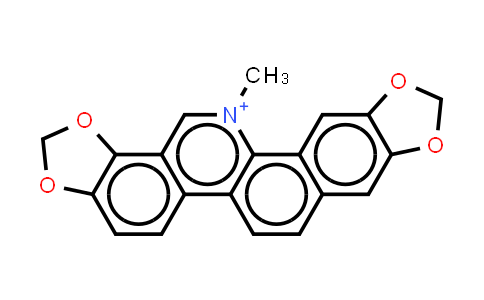| Chemical Name |
Sanguinarine |
| CAS Number |
2447-54-3 |
| MDL Number |
MFCD00064925 |
| Molecular Formula |
C20H14NO4 |
| Molecular Weight |
332.33 |
| Synonyms |
Pseudochelerythrine;Sanguinarin |
Introduction of 2447-54-3 :
Sanguinarine, a benzophenanthridine alkaloid derived from the root of Sanguinaria Canadensis, can stimulate apoptosis via activating the production of reactive oxygen species (ROS). Sanguinarine-induced apoptosis is associated with the activation of JNK and NF-κB. IC50 & Target: Apoptosis[1] In Vitro: Sanguinarine (SANG)-induced apoptosis is associated with the activation of JNK and NF-κB signal pathways.To determine the effects of Sanguinarine on cell viability, 22B-cFluc cells are stimulated with different concentrations of Sanguinarine for 24 h, and then a CKK-8 assay is performed. The treatment with Sanguinarine decreases the proliferation of 22B cells in a dose-dependent manner. Meanwhile, the cytosolic extracts of 22B-cFluc cells treated with different dose of Sanguinarine are measured to detect cellular caspase-3 activity using Ac-DEVD-pNA, which is a validated caspase-3 substrate. The absorbance at 450 nm increases in a dose-dependent manner, indicating increased caspase-3 activity stimulated by Sanguinarine[1]. In Vivo: To evaluate the apoptosis induced by Sanguinarine (SANG) in vivo, 22B-cFluc cells are inoculated subcutaneously into one flank of nude mice and xenograft models are allowed to establish. Mice are treated intravenously with 10 mg/kg of Sanguinarine. At 24, 48 and 72 h after treatment, bioluminescent imaging is performed after i.p. injection of mice with 150 mg/kg of D-luciferin substrate. Sanguinarine treatment induces an obvious increase of luminescent signal as early as 48 h after initial treatment. A sustained bioluminescent imaging (BLI) intensity increased is observed throughout the course of experiment. At 72 h after treatment, the tumors are collected and subjected to TUNEL staining for evaluating apoptosis. Compared with the control tumors, the group treated with Sanguinarine exhibits significantly more cell apoptosis, indicated by the increased green signals from the sporadic apoptotic cells[1].
| Purity |
NLT 98% |
| Storage |
at 20ºC 2 years |
*The above information is for reference only.
